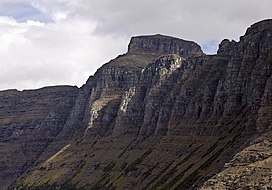| Pollock Mountain | |
|---|---|
 Pollock Mountain above the Garden Wall | |
| Highest point | |
| Elevation | 9,195 ft (2,803 m) [1] |
| Prominence | 550 ft (170 m) [1] |
| Coordinates | 48°43′01″N 113°42′09″W / 48.71694°N 113.70250°W [2] |
| Naming | |
| Etymology | William C. Pollock |
| Geography | |
| Location |
Flathead County /
Glacier County Montana, U.S. |
| Parent range | Lewis Range |
| Topo map | USGS Logan Pass, MT |
Pollock Mountain (9,195 feet (2,803 m)) is located in the Lewis Range, Glacier National Park in the U.S. state of Montana. [3] Pollock Mountain is situated along the Continental Divide and is one of the peaks along the Garden Wall and is approximately .6 miles (0.97 km) south of Bishops Cap. The mountain was named by Ross Carter for William C. Pollock, a member of the Indian Commission who along with Walter M. Clements and George Bird Grinnell negotiated with the Blackfeet to consummate the treaty that enabled the Federal Government to purchase the "Ceded Strip" of land, which included all of what is now Glacier National Park to the east of the Continental Divide. [4]
Geology
Like other mountains in Glacier National Park, the peak is composed of sedimentary rock laid down during the Precambrian to Jurassic periods. Formed in shallow seas, this sedimentary rock was initially uplifted beginning 170 million years ago when the Lewis Overthrust fault pushed an enormous slab of precambrian rocks 3 mi (4.8 km) thick, 50 miles (80 km) wide and 160 miles (260 km) long over younger rock of the cretaceous period. [5]

Climate
Based on the Köppen climate classification, the peak is located in an alpine subarctic climate zone with long, cold, snowy winters, and cool to warm summers. [6] Temperatures can drop below −10 °F with wind chill factors below −30 °F.
See also
References
- ^ a b "Pollock Mountain, Montana". Peakbagger.com. Retrieved December 27, 2018.
- ^ "Pollock Mountain". Geographic Names Information System. United States Geological Survey, United States Department of the Interior. Retrieved December 27, 2018.
- ^ Logan Pass, MT (Map). TopoQwest (United States Geological Survey Maps). Retrieved December 26, 2018.
- ^ Through The Years In Glacier National Park An Administrative History, NPS.gov
-
^ Gadd, Ben (2008). "Geology of the Rocky Mountains and Columbias".
{{ cite journal}}: Cite journal requires|journal=( help) - ^ Peel, M. C.; Finlayson, B. L.; McMahon, T. A. (2007). "Updated world map of the Köppen−Geiger climate classification". Hydrol. Earth Syst. Sci. 11 (5): 1633–1644. Bibcode: 2007HESS...11.1633P. doi: 10.5194/hess-11-1633-2007. ISSN 1027-5606. S2CID 9654551.


